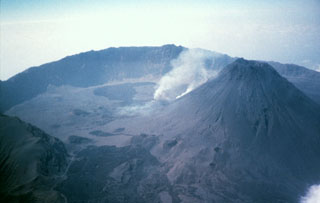Report on Fogo (Cabo Verde) — 3 December-9 December 2014
Smithsonian Institution / US Geological Survey
Weekly Volcanic Activity Report, 3 December-9 December 2014
Managing Editor: Sally Sennert.
Please cite this report as:
Global Volcanism Program, 2014. Report on Fogo (Cabo Verde) (Sennert, S, ed.). Weekly Volcanic Activity Report, 3 December-9 December 2014. Smithsonian Institution and US Geological Survey.
Fogo
Cabo Verde
14.95°N, 24.35°W; summit elev. 2829 m
All times are local (unless otherwise noted)
According to news articles the eruption from Fogo's Pico cone inside the Cha Caldera continued during 3-9 December. The eruption became more intense on 6 December with lava flows traveling at a rate of 30 meters per hour. By that afternoon 20 houses in the N half of Portela had been destroyed, and authorities ordered a complete evacuation of the area. The third access road that allowed for residents to retrieve property was being covered by lava. Later that day lava reached the town of Bangaeira. More than half of Bangaeira was inundated by the very fluid lava and by the evening only a few houses remained. Flights from the island to a few other locations were cancelled due to ash emissions. By 8 December about 90% of Bangaeira and 95% of Portela were overtaken by the flows which, and as noted by the article, destroyed 100 years of town history. After moving through the towns the lava-flow front was about 300 m wide. By 8 December the almost 1,500 residents of the caldera had been evacuated, with 848 of them in shelters. Lava-flow advancement slowed on 9 December.
Geological Summary. The island of Fogo consists of a single massive stratovolcano that is the most prominent of the Cape Verde Islands. The roughly circular 25-km-wide island is truncated by a large 9-km-wide caldera that is breached to the east and has a headwall 1 km high. The caldera is located asymmetrically NE of the center of the island and was formed as a result of massive lateral collapse of the older Monte Armarelo edifice. A very youthful steep-sided central cone, Pico, rises more than 1 km above the caldera floor to about 100 m above the rim. Pico, which is capped by a 500-m-wide, 150-m-deep summit crater, was apparently in almost continuous activity from the time of Portuguese settlement in 1500 CE until around 1760. Later lava flows, some from vents on the caldera floor, reached the eastern coast below the breached caldera.
Source: Fogo News

